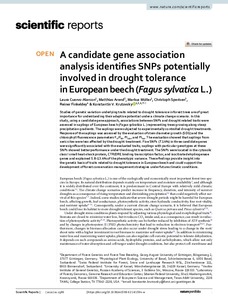Показать сокращенную информацию
A candidate gene association analysis identifies SNPs potentially involved in drought tolerance in European beech (Fagus sylvatica L.)
| Автор | Cuervo-Alarcon L. | |
| Автор | Arend M. | |
| Автор | Müller M. | |
| Автор | Sperisen C. | |
| Автор | Finkeldey R. | |
| Автор | Krutovsky K.V. | |
| Дата внесения | 2021-02-15T13:34:47Z | |
| Дата, когда ресурс стал доступен | 2021-02-15T13:34:47Z | |
| Дата публикации | 2021 | |
| ISSN | 20452322 | |
| URI (для ссылок/цитирований) | https://elib.sfu-kras.ru/handle/2311/137962 | |
| Описание | Статья из журнала. | |
| Аннотация | Studies of genetic variation underlying traits related to drought tolerance in forest trees are of great importance for understanding their adaptive potential under a climate change scenario. In this study, using a candidate gene approach, associations between SNPs and drought related traits were assessed in saplings of European beech (Fagus sylvatica L.) representing trees growing along steep precipitation gradients. The saplings were subjected to experimentally controlled drought treatments. Response of the saplings was assessed by the evaluation of stem diameter growth (SDG) and the chlorophyll fluorescence parameters FV/FM, PIabs, and PItot. The evaluation showed that saplings from xeric sites were less affected by the drought treatment. Five SNPs (7.14%) in three candidate genes were significantly associated with the evaluated traits; saplings with particular genotypes at these SNPs showed better performance under the drought treatment. The SNPs were located in the cytosolic class I small heat-shock protein, CTR/DRE binding transcription factor, and isocitrate dehydrogenase genes and explained 5.8–13.4% of the phenotypic variance. These findings provide insight into the genetic basis of traits related to drought tolerance in European beech and could support the development of forest conservation management strategies under future climatic conditions. © 2021, The Author(s). Studies of genetic variation underlying traits related to drought tolerance in forest trees are of great importance for understanding their adaptive potential under a climate change scenario. In this study, using a candidate gene approach, associations between SNPs and drought related traits were assessed in saplings of European beech (Fagus sylvatica L.) representing trees growing along steep precipitation gradients. The saplings were subjected to experimentally controlled drought treatments. Response of the saplings was assessed by the evaluation of stem diameter growth (SDG) and the chlorophyll fluorescence parameters FV/FM, PIabs, and PItot. The evaluation showed that saplings from xeric sites were less affected by the drought treatment. Five SNPs (7.14%) in three candidate genes were significantly associated with the evaluated traits; saplings with particular genotypes at these SNPs showed better performance under the drought treatment. The SNPs were located in the cytosolic class I small heat-shock protein, CTR/DRE binding transcription factor, and isocitrate dehydrogenase genes and explained 5.8–13.4% of the phenotypic variance. These findings provide insight into the genetic basis of traits related to drought tolerance in European beech and could support the development of forest conservation management strategies under future climatic conditions. © 2021, The Author(s). | |
| Аннотация | Studies of genetic variation underlying traits related to drought tolerance in forest trees are of great importance for understanding their adaptive potential under a climate change scenario. In this study, using a candidate gene approach, associations between SNPs and drought related traits were assessed in saplings of European beech (Fagus sylvatica L.) representing trees growing along steep precipitation gradients. The saplings were subjected to experimentally controlled drought treatments. Response of the saplings was assessed by the evaluation of stem diameter growth (SDG) and the chlorophyll fluorescence parameters FV/FM, PIabs, and PItot. The evaluation showed that saplings from xeric sites were less affected by the drought treatment. Five SNPs (7.14%) in three candidate genes were significantly associated with the evaluated traits; saplings with particular genotypes at these SNPs showed better performance under the drought treatment. The SNPs were located in the cytosolic class I small heat-shock protein, CTR/DRE binding transcription factor, and isocitrate dehydrogenase genes and explained 5.8–13.4% of the phenotypic variance. These findings provide insight into the genetic basis of traits related to drought tolerance in European beech and could support the development of forest conservation management strategies under future climatic conditions. © 2021, The Author(s). | |
| Издатель | Nature Research | |
| Является частью серии | Vol. 11, Is. 1 | |
| Название | A candidate gene association analysis identifies SNPs potentially involved in drought tolerance in European beech (Fagus sylvatica L.) | |
| Тип | Journal Article | |
| Контакты автора | Cuervo-Alarcon L.: Department of Forest Genetics and Forest Tree Breeding, Georg-August University of Göttingen, Büsgenweg 2, Göttingen, 37077, Germany | |
| Контакты автора | Arend M.: Physiological Plant Ecology, University of Basel, Schönbeinstrasse 6, Basel, 4056, Switzerland | |
| Контакты автора | Müller M.: Department of Forest Genetics and Forest Tree Breeding, Georg-August University of Göttingen, Büsgenweg 2, Göttingen, 37077, Germany | |
| Контакты автора | Sperisen C.: Swiss Federal Institute for Forest, Snow and Landscape Research WSL, Zürcherstrasse 111, Birmensdorf, 8903, Switzerland | |
| Контакты автора | Finkeldey R.: University of Kassel, Mönchebergstrasse 19, Kassel, 34109, Germany | |
| Контакты автора | Krutovsky K.V.: Department of Forest Genetics and Forest Tree Breeding, Georg-August University of Göttingen, Büsgenweg 2, Göttingen, 37077, Germany, Vavilov Institute of General Genetics, Russian Academy of Sciences, 3 Gubkina Str., Moscow, 119333, Russian Federation, Laboratory of Foresty Genomics, Genome Research and Education Center, Siberian Federal University, 50a/2 Akademgorodok, Krasnoyarsk, 660036, Russian Federation, Department of Ecosystem Science and Management, Texas A&M University, 2138 TAMU, College Station, TX 77843-2138, United States | |
| Страницы | 2386 | |
| DOI | 10.1038/s41598-021-81594-w | |
| Журнал | Scientific Reports | |
| Квартиль журнала в Scopus | да | |
| Шифр в ИРБИС | 480309705-142374184 |

